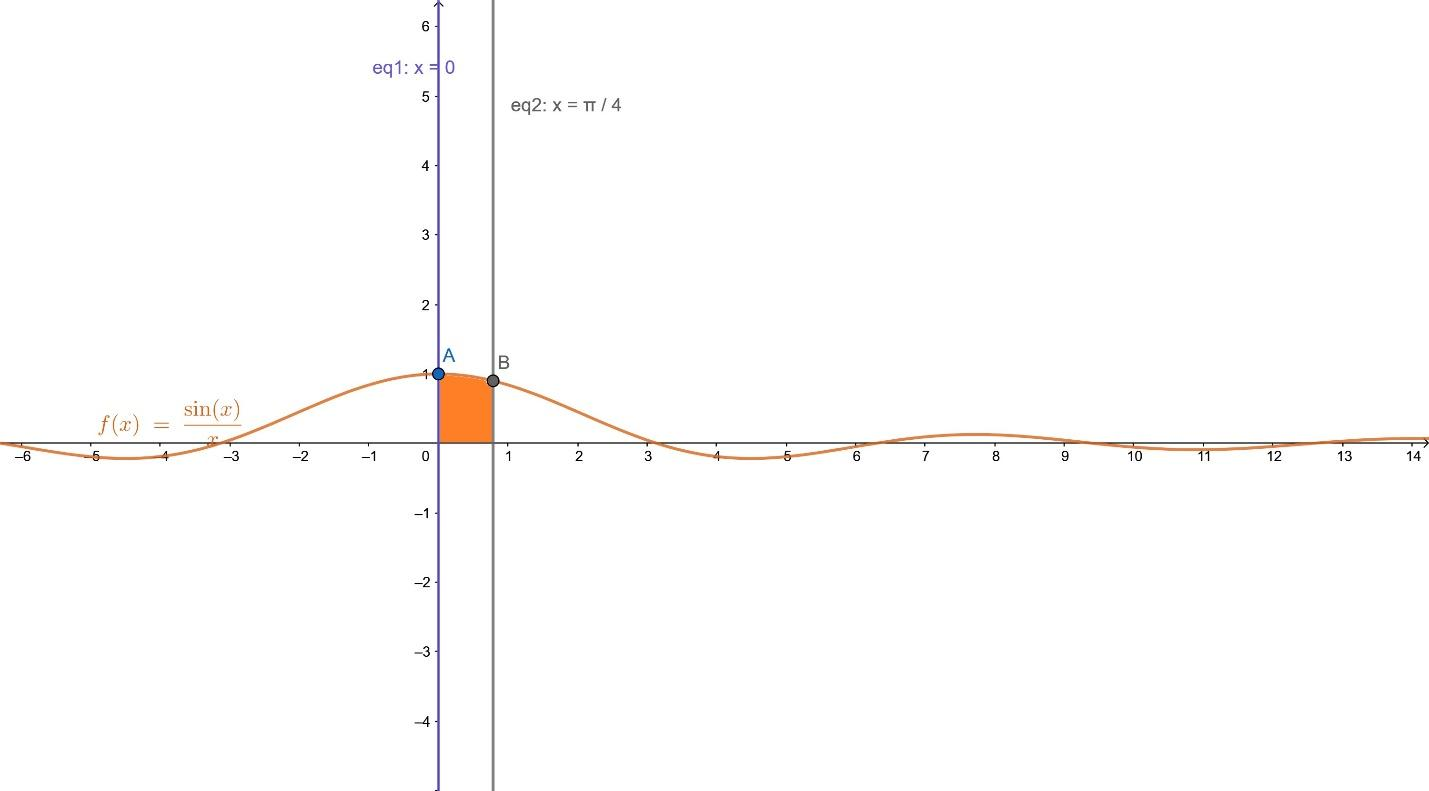
The area bounded by $y = \dfrac{{\sin x}}{x}$ , $x$ -axis and the ordinates $x = 0,x = \dfrac{\pi }{4}$ is
A.$ = \dfrac{\pi }{4}$
B.$ < \dfrac{\pi }{4}$
C.$ > \dfrac{\pi }{4}$
D.$ < \int\limits_0^{\dfrac{\pi }{4}} {\dfrac{{\tan x}}{x}} dx$
Answer
603.9k+ views
Hint: Area under the curve will be determined using integration of a given function in the range $(0,\dfrac{\pi }{4})$ so draw the required graph of it before starting solving. And expand the function up to infinite terms.
Complete Step-by-Step solution:
The area under the curve between two points can be determined by using definite integral between the two points.
First step is to draw the diagram for proper understanding,

We know the area under the curve is found by integrating the curve between given ordinates.
Here, we integrate f(x) from $x = 0$ & $x = \dfrac{\pi }{4}$ .
Required area $ = \int\limits_0^{\dfrac{\pi }{4}} {f(x)dx} $
$I = \int\limits_0^{\dfrac{\pi }{4}} {\dfrac{{\sin x}}{x}} dx$
We know the expansion of $\sin x$ .
$\sin x = x - \dfrac{{{x^3}}}{{3!}} + \dfrac{{{x^5}}}{{5!}} - \dfrac{{{x^7}}}{{7!}} + ......$
So,
$I = \int\limits_0^{\dfrac{\pi }{4}} {\dfrac{{(x - \dfrac{{{x^3}}}{{3!}} + \dfrac{{{x^5}}}{{5!}} - \dfrac{{{x^7}}}{{7!}} + ......)}}{x}dx} $
Each term is divided by ‘x’, we get
$I = \int\limits_0^{\dfrac{\pi }{4}} {(1 - \dfrac{{{x^2}}}{{3!}}} + \dfrac{{{x^4}}}{{5!}} - \dfrac{{{x^6}}}{{7!}} + .....)dx$
We know, $\int {{x^n}dx = } \dfrac{{{x^{n + 1}}}}{{n + 1}}$
$I = [x - \dfrac{{{x^3}}}{{3 \times 3!}} + \dfrac{{{x^5}}}{{5 \times 5!}} - \dfrac{{{x^7}}}{{7 \times 7!}} + ....]_0^{\dfrac{\pi }{4}}$
$I = [\dfrac{\pi }{4} - \dfrac{{{{(\dfrac{\pi }{4})}^3}}}{{3 \times 3!}} + \dfrac{{{{(\dfrac{\pi }{4})}^5}}}{{5 \times 5!}} - ....]$
Now,
We can observe that it must be less than $\dfrac{\pi }{4}$ as some terms are subtracted from $\dfrac{\pi }{4}$.
So, correct answer is <$\dfrac{\pi }{4}$
option B) is correct.
Note: We know that we cannot find the value of ‘x’ at 0 as it would become undetermined i.e. $(\dfrac{0}{0})$form. To find the value of $\dfrac{{\sin x}}{x}$ at $x = 0$ is 1, we use the limit here to find its value at $x = 0$ .
.. . $\dfrac{{\sin x}}{x}$ is approaching zero at infinity.
And series expansion of $\sin x$ can be determined using the Maclaurin or Laurent method.
Complete Step-by-Step solution:
The area under the curve between two points can be determined by using definite integral between the two points.
First step is to draw the diagram for proper understanding,

We know the area under the curve is found by integrating the curve between given ordinates.
Here, we integrate f(x) from $x = 0$ & $x = \dfrac{\pi }{4}$ .
Required area $ = \int\limits_0^{\dfrac{\pi }{4}} {f(x)dx} $
$I = \int\limits_0^{\dfrac{\pi }{4}} {\dfrac{{\sin x}}{x}} dx$
We know the expansion of $\sin x$ .
$\sin x = x - \dfrac{{{x^3}}}{{3!}} + \dfrac{{{x^5}}}{{5!}} - \dfrac{{{x^7}}}{{7!}} + ......$
So,
$I = \int\limits_0^{\dfrac{\pi }{4}} {\dfrac{{(x - \dfrac{{{x^3}}}{{3!}} + \dfrac{{{x^5}}}{{5!}} - \dfrac{{{x^7}}}{{7!}} + ......)}}{x}dx} $
Each term is divided by ‘x’, we get
$I = \int\limits_0^{\dfrac{\pi }{4}} {(1 - \dfrac{{{x^2}}}{{3!}}} + \dfrac{{{x^4}}}{{5!}} - \dfrac{{{x^6}}}{{7!}} + .....)dx$
We know, $\int {{x^n}dx = } \dfrac{{{x^{n + 1}}}}{{n + 1}}$
$I = [x - \dfrac{{{x^3}}}{{3 \times 3!}} + \dfrac{{{x^5}}}{{5 \times 5!}} - \dfrac{{{x^7}}}{{7 \times 7!}} + ....]_0^{\dfrac{\pi }{4}}$
$I = [\dfrac{\pi }{4} - \dfrac{{{{(\dfrac{\pi }{4})}^3}}}{{3 \times 3!}} + \dfrac{{{{(\dfrac{\pi }{4})}^5}}}{{5 \times 5!}} - ....]$
Now,
We can observe that it must be less than $\dfrac{\pi }{4}$ as some terms are subtracted from $\dfrac{\pi }{4}$.
So, correct answer is <$\dfrac{\pi }{4}$
option B) is correct.
Note: We know that we cannot find the value of ‘x’ at 0 as it would become undetermined i.e. $(\dfrac{0}{0})$form. To find the value of $\dfrac{{\sin x}}{x}$ at $x = 0$ is 1, we use the limit here to find its value at $x = 0$ .
.. . $\dfrac{{\sin x}}{x}$ is approaching zero at infinity.
And series expansion of $\sin x$ can be determined using the Maclaurin or Laurent method.
Recently Updated Pages
Two men on either side of the cliff 90m height observe class 10 maths CBSE

What happens to glucose which enters nephron along class 10 biology CBSE

Cutting of the Chinese melon means A The business and class 10 social science CBSE

Write a dialogue with at least ten utterances between class 10 english CBSE

Show an aquatic food chain using the following organisms class 10 biology CBSE

A circle is inscribed in an equilateral triangle and class 10 maths CBSE

Trending doubts
Why is there a time difference of about 5 hours between class 10 social science CBSE

Write a letter to the principal requesting him to grant class 10 english CBSE

What is the median of the first 10 natural numbers class 10 maths CBSE

The Equation xxx + 2 is Satisfied when x is Equal to Class 10 Maths

Which of the following does not have a fundamental class 10 physics CBSE

State and prove converse of BPT Basic Proportionality class 10 maths CBSE




